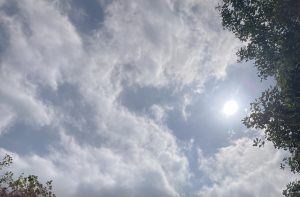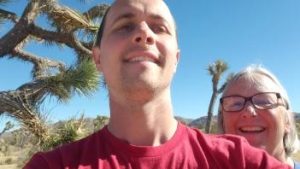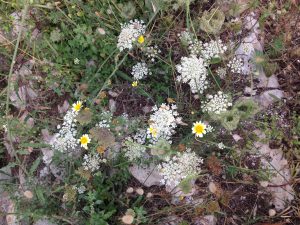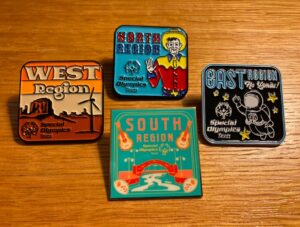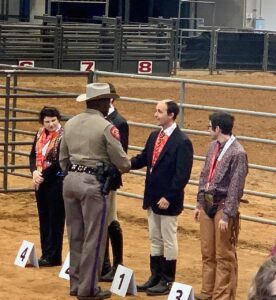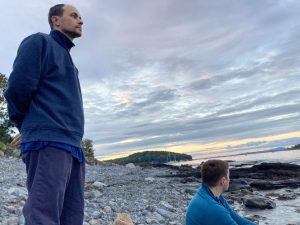adults with autism
A lot of slop and wobble
The words about to unfold below weren’t exactly how I planned to start or end this post. The house is quiet and Sam is likely napping. We just finished a Sunday bike ride down the rail trail, which felt a little like a victory lap today. On Monday, we rode the trail all the way to Lewisville Lake so we could get a good, long time with totality.
(That supposed life hack of holding solar glasses to your smartphone to shoot the eclipse? I stopped trying to take photos after this shot. I cherish the images in my memory. It was an unparalleled life experience–babies being born, totality, etc., etc.)
Today’s victory lap was marred by a motorist who chose the moment he passed us (we were waiting at the McKinney Street crosswalk by City Hall) to lay on his horn a good long time. A few motorists have done that to us in the past. Each time, as the adrenaline shoots through you, it feels a bit like someone punched you in the face.
Whether honking a horn like that should be considered assault may feel like an open question. Yet Sam’s reaction today, as in the past, convinces me that it is. He’s a beast of a cyclist, but after the horn, he took off like a cheetah. He was already through Quakertown Park and halfway down Congress Avenue by the time I got to the little bridge over Pecan Creek.
For the rest of the ride home, he’d pedal at incredible speeds and have to circle back to meet me before taking off again. I can’t imagine how much adrenaline is coursing through a person’s body that it takes more than two miles of fast pedaling to work it off. During one circle back, he said to me, “I’m a good person. But it doesn’t matter to him. That’s why I can’t feel safe.”
Risk is always with us. It’s hard to calculate sometimes. I borrowed today’s headline from a Washington Post story about calculating Earth’s rotation. I never doubted the math for the eclipse, which takes into account the slop and wobble of our little orbit around the sun. It was marvelous to sit on the lakeshore Monday, looking up through solar glasses to watch the eclipse start and progress and make the world go dark, just like they calculated.
A lot of modern life takes all this elegant math for granted. We need to remember that the world may speak in calculus, but life is not precise. What makes some math so elegant is that it hasn’t forgotten about all of life’s beautiful slop and wobble.
I suppose we could stop riding bike, but that’s no way to address the risk. Or we could insist that police ticket motorists for assault when they use their horns that way, but that introduces other risks.
Or, maybe I could write an essay about life’s slop and wobble, sending a little message out into the world that asks everyone to please be kind to all cyclists, because you don’t know which ones might be autistic.
Don’t sand down a square peg and call it support
For the past several months, I’ve been reading the research on adults with autism. The work should help me prepare for the next book but, more importantly, help me do a little better in this current chapter of life.
In surveys of the research literature on adults with autism, several authors say there’s not much out there. There was even less research 20 years ago, so I’m not beating myself up for being late to this party.
When Sam was a toddler, I emptied library shelves, checking out books, looking for answers. Back then, autism research had barely exited the blame-the-mother stage and was focusing on young children. I found Maria Montessori’s original treatises and other general child development research and writings the most helpful. Over the years, I believe that concept—looking first to the big, fundamental ideas and then to the science that follows—has worked well for our family, which feels forever on the front lines.
For example, a recent study set out to create a sturdy vocational index for adults with autism. Why do we need such a thing? The researchers’ answers had a lot to do with shoring up future research and policymaking. But for the rest of us, who are watching our loved ones and their peers go after their employment and higher education goals right now, it can still help to be precise in describing current conditions and supports.
After all, the first step in solving a problem is identifying what it is.
In this particular study, the vocational index would score Sam’s work conditions and supports at the top, since he works full-time with the same support as any other warehouse employee. The index would score the work conditions and support of another young man we know just a little lower, because his work was part-time and he had additional support from a job coach.
That differentiation is a small step forward, but the rest of this young man’s story shows it also has its limits.
Like Sam, he has autism. Until recently, he was working on the retail floor at a pharmacy.
The pharmacy, which is part of a national chain, is participating in one of the state’s workforce programs. In addition, a former special education teacher served as his job coach. In the end, the job didn’t work out, and I’ll bet you, dear reader, already know why.
His family recognized something off in the support he was getting, but it wasn’t readily apparent what was wrong. After all, someone was there, someone whose job was to help him.
Ultimately, the job coach was meeting the pharmacy’s needs first, not the employee’s. The company needed workers. Joining the state’s workforce program allowed the company to tap a new pool of workers with little risk or investment on its part. And that showed.
As a former special education teacher, the job coach should know that a robust assessment of the worker’s skills and the workplace conditions comes first. Just based on our early experiences, I’ve got a pretty good idea how perfunctory that fellow’s assessment probably was. Sam’s first job placement was sacking groceries because that was all the state’s workforce program had to offer. They honestly didn’t look too hard at whether the job was a good fit.
It was clear that the pharmacy wrote up a task list long before any potential employee came through the program with their own strengths and skills to offer the store. Unsurprisingly, it can be a lot to ask some individuals with autism to respond to the shopping public. Sam says he couldn’t imagine doing it today. Some customers were already awful when he was sacking groceries years ago, and these days, there seem to be more awful customers and some just go off the rails with their complaints. So when this fellow’s job coach decided that he needed to pause the program and get some behavioral training instead, it was clear something else had gone off the rails.
This young man sometimes answers questions in long-winded ways, and some of the pharmacy staff and the customers didn’t like it. The coach didn’t either. We’ve all heard about the square peg that doesn’t fit in a round hole. We know the answer isn’t to send the peg out for sanding down, and down, and down. But that’s what was passing for job support for this fellow.
So the next question has to be, how do we measure support in the index, or how do we make sure what’s passing for support is actually support?
New year, new book?
If declaring a New Year’s resolution out loud helps you be accountable for it, I’m here for it, dear readers. About half way through the book I co-wrote with Shahla, I recognized the need for a book for parents of adults with disabilities. A book about transition.
For parents sending their grown child with a disability out into the world, the word “transition” has become the shorthand for this journey. The word is both dead-on accurate and completely wrong.
Most families start planning for transition long before a high school graduation. There is a lot to think about. What’s next—a workshop, job placement, vocational training, college? Where will they live? How can we find adult health care providers to replace the pediatric team? What other services will they need as an adult? Where will the money come from?
All these questions deserve answers, even though the resources needed to support choices and pursue dreams after high school are often different than those available in school. If those resources even exist. Many families describe transition planning as going off a cliff.
Our family’s journey felt like that sometimes. But the more I tried to think about transition as a journey, the more it felt like we could build resilience.
Sam says his New Year’s resolution this year will be building resilience. I think he understands where we are now and where he wants the path to go.
Sam and other young adults with disabilities deserve to be surrounded by people who respect and honor their agency and humanity, no matter what long-term supports they need.
The truth is, we all need support of one kind or another, especially as we age. Some support flows readily from modern life—grocery delivery, cleaning services, public transit. Other connections can be elusive—meaningful friendships, helpful neighbors, extended family relationships. Yet we know that any community can grow stronger when each and every person makes their full contribution to its betterment. That’s where resilience comes from.
That will be the purpose of this new book, harnessing the “big ideas” families need to make transition feel less like going off cliff and more like taking flight.
Oh, and my other resolution will be to finally learn how to make pie crust. Tips welcome.
Road trip
It took some time to notice, but both Sam and I agree the pandemic made our lives a little smaller.
Don’t get me wrong. There were things we did, things we neglected, routines we filled, habits we clung to, all that needed to change. And we stopped being busy for busy’s sake (what was that about?)
But ‘opting out’ also sets its own traps. A certain brittleness can settle in. We needed to stretch.
We’ve gone on cycling trips to help with that. Acadia National Park in 2021. Lake Champlain in 2022. But this year, we felt like we needed to nudge in another direction. After we were invited to a wedding in Phoenix, I got out the maps and started studying road trips. After all, Phoenix is just a few hours from California. As a good friend says, it’s just “map math.”
But I wasn’t planning a grand tour. This trip could reconnect us to our family’s origin story. Sam and his brother and sister were all born in Sacramento. Their father was principal tuba of the Sacramento Symphony until it went bankrupt. We lived there until Sam was 5 years old.
A road trip could help Sam see that he was a Californian and still belonged, if he wanted that option. We took the kids to California several times on summer trips. Sam went back to visit once on his own (his godparents live in Stockton) when he was in his 20s. But visiting a place for fun is different than visiting with an eye toward making a life there.
Many of us don’t always feel we have options and sometimes this seems more so for Sam. We planned this trip to explore his options,. The company he works for has a similar facility in Modesto. Touring the Modesto location could help him think about his future in new ways.
We had all the fun we could stay awake for in Phoenix, and headed out the next day. We took a nice, leisurely detour through Joshua Tree National Park (amazing!) and spent the night nearby.
Then the next day we headed to Modesto, stopping in Fresno. I suggested a stop at an underground garden. I thought it would be a world’s-largest-ball-of-twine-roadside-attraction type of stop, but it turned out to be a national landmark and completely charming.
The next day, we toured the Modesto facility and wouldn’t you know, Sam already knew some of the people working there. They didn’t have any openings right then, but that’s not how Sam thinks things through anyways.
In the month since, though, I’ve heard him say many, many times, “I have options now, Mom.”
Never, ever underestimate the power of a road trip.
Fledging
Late last week, walking with Fang, we came upon a red-shouldered hawk that had just made a kill near Rayzor Ranch Park. She was standing in a field with the varmint in her talons. The varmint seemed a little too silky brown and big to be a rabbit. There are a few jackrabbits in what is left of the old Rayzor Ranch. Or it could’ve been a nutria from the nearby retention pond.
I have seen this a few times before, this waiting after a kill. Once, a hawk had landed on a rat running in our postage stamp of a backyard in California. We watched through the dining room window as the hawk waited patiently until it was safe to fly off with her prey.
But this time, a scissor tail from the park decided there was no room in the new ‘hood for a hawk. I watched in wonder as the scissor tail dove for the hawk’s back, triggering the raptor to drop its prey and lift off. The scissor tail rode on that hawk’s back for a few hundred yards before veering off and back to the park.
I knew why she was doing that. A few days before, we were walking to that park (Fang likes Rayzor Ranch Park a lot.) At one point, I was almost face to face with a pair of scissor tails fledging their young — three little guys who didn’t have their scissor feathers yet, but were flying pretty well. They had just regrouped in one of the younger trees in the park, so they were barely hidden. The parents had tucked wings and tail feathers around them, as they all wiggled and peeped and got ready to fly again. We caught up with them a second time not far away, all three fledglings perched on a fence, side by side, peeping and wiggling and trying to decide whether Fang and I warranted another flight attempt as their parents flew overhead.
The sight of it all triggered a fast rewind in my brain, other times we’ve stumbled on fledging as we’ve walked. Once in a neighborhood to the east, a fledgling raptor had to be nearby–although I never saw it–because a Mississippi kite grazed me three times until we finally went around a corner. (I was so glad to be wearing a sturdy hat.)
Another time, I saw a pair of mourning doves standing unusually close to one another, perched on the next-door neighbor’s roof. I looked around and saw the fledgling in the gutter. The little guy wasn’t going to make it. I scooped up its body the next day.
Another time I didn’t see the fledgling until just after Fang spotted it hopping in the leaf litter beneath the oaks in McKenna Park. First the momma robin dove at Fang, and then the poppa. Fang immediately lost interest in the fledgling and was already crying uncle. But a call went out anyways and within seconds, every robin in the park was diving at the two of us, like a Hitchcock horror movie.
I got curious about how much scientists know about fledging and bird behavior. We don’t know a whole lot. I found a research study from 2018. This study suggested to researchers that fledging is negotiated between the young and the parents, with different species tolerating longer stays than others. Young birds that leave before they can fly very well have a higher mortality rate, of course. The scissor tails certainly had to fledge before their tails got too long, as my own mother adeptly noted. But the young that stay too long risk discovery by predators who bring jeopardy to the entire nest, parents included.
I’m not sure how well we humans do at fledging. Actually, in terms of survival of the human race, rather poorly, I think. We understand child development a little better than adult development. New research suggests a stage of emerging adulthood that warrants our closer attention. And, as most of us disability parents will tell you, fledging a child with a disability is tough. We have organized our culture in ways that discourage cooperation and care for one another, unless doing it for money. Can you imagine being like a robin and joining the entire flock to defend someone else’s child? We are too fond of gaming the economic rules so that one group or another gains an edge, instead of raising all boats. We do this change-up so often that it’s hard even for kids without disabilities to launch.
Maybe there’s a reason we know we are doomed. Maybe there are lessons from nature. Before it’s too late.
A rose behind a geofence is just a rose, fenced
The word geofence joined the English language in the mid-1990s. As I type the word “geofence”, Microsoft Word doesn’t correct my spelling—yet, chances are high that if I want to talk with Sam about geofencing, the first thing we would have to do is talk about the word’s definition in plain language.
Sam inspired me to become a plain language fan. It’s not just because we now have the Plain Writing Act of 2010, a federal law that sets the standards for certain government agencies to better communicate with people.
When talking with Sam in plain language, we usually find some great truths. We have to be thinking very clearly to boil stuff down to its essence. And then Sam, always a great thinker, figures out what that essence means and where that new essence belongs in his life.
So, the word “geofence” in plain language: A boundary line on your computer.
We sometimes say that good fences make good neighbors. The poet Robert Frost had more to say about that. In other words, a fence on a computer has meaning, too.
Our local transit agency, DCTA, experimented with a computer fence to offer van rides to the west side of town a few years ago. Sam used that van service to get to work a few times. It was very hard. I rode with him once. First, you had to travel to the fence line, then you could hail the van that only gave you rides inside the fence lines.
The day I went with him, I had to wait a half-hour to ride back to the other side of the fence. While waiting, I saw dozens of DCTA vans driving Peterbilt workers to destinations that I knew were traveling far beyond the fence lines I was traveling in.
Recently, our transit agency has drawn new fence lines for van rides. At first glance, the big pasture of service seems generous. But at the same time, they also cut most of the buses whose lines weren’t fences, but veins.
Suddenly, yet predictably, too many riders are coming from certain areas. DCTA says they may “geofence to manage demand.”
Or, in plain language: they will draw lines that push riders out.
Sam has told me more than once that he wants to ride bus to work. I began to doubt whether that would ever happen after I saw the long line of Peterbilt-subsidized DCTA vanpools. Then, when an apartment developer paid extra for DCTA to run a bus to its massive apartment complex adjacent to the warehouse district (beyond even the millions UNT pays DCTA to run buses), I gave up hope. We don’t, and probably won’t ever, have a system to serve the thousands of people like Sam, who can make their lives better with the mobility that connects them to economic opportunities–let alone the magical world that exists for all of us when our community has that kind of mobility.
Some politicians (and their constituents, of course) will always be attracted to lines like geofencing. Playground games follow the boundary lines. Winners and losers are determined by the lines. And, as we all know, some kids aren’t allowed inside the boundaries to play at all.
I doubt our transit agency board recognizes the deepest meaning of its actions as it draws these lines. The longer they allow those fence lines to exist on computers, the more those lines become real-life walls.
See Sam Drive, Horse and Cart Edition
Sam started driving lessons about two years ago. Sam would watch other riders at Born 2 Be dress up in costumes and drive their carts in exhibition drills that he enjoyed watching. I mentioned he didn’t have to resign himself to watching, he could participate and he finally decided to give it a try.
Today wasn’t his first competition, but it was the first time I was able to go and get video for you, dear internet readers. We got to the stables (near Terrell) about 9 this morning, in time for Sam to watch his instructor and many of the other competitors. His class was the last of the day to compete, and he was the last competitor. (You will see that he is joined in the cart by his instructor as a safety measure. Also, we very grateful that it was all done by noon. We both napped after we got home. It’s going to be a long and very hot summer this year.)
He said that he planned to trot the “Fault and Out” course. He’d seen a few people scratch over the course of the morning, but he was confident in his ability, along with Doc’s, to weave the cones. You can hear the whistle after the sixth set. In the stands, we were all surprised to hear the whistle because it looked like they were through, but Sam knew. He had to stop because he and Doc had knocked a tennis ball off the top of the cone. That’s the Fault. So they were Out.
Things went better for the Gambler’s Choice obstacle course. I learned that this, too, is a timed event, unlike trail patterns for riders. The more times he and Doc completed one of the obstacles, the more points they got. You will see that Sam started to try to back Doc and the cart into the U and bump out the back, but when things slowed down too much, he wisely gave up. I learned later that it’s quite difficult for a horse to back a four-wheel cart without jackknifing it.
After the events were over, one of the technical judges came by to encourage Sam and tell him what all went right. Sam told her he just wanted to finish the course anyways, because it was fun.
Racing alone. That’s the spirit.
Look for the Paul Hollywood handshake
For the first time in three years (thanks, pandemic), equestrians gathered for the statewide Special Olympics in Bryan last weekend. Sometimes, it felt like we hadn’t missed a beat (showmanship classes rolled like clockwork Sunday morning even though we were tired from the dance the night before) and other times, the grief over the lost time hit hard (hello, friend I haven’t hugged in five years).
I have to tip my hat at the organizers that recognized the athletes would benefit from an icebreaker after all these years. They outfitted each athlete with four of the same pins for their region. They had to meet riders from all the other regions in order to exchange pins and collect a full set: North, South, East, West.
It was fun to watch Sam and all the other athletes not only reach out to one another, but help one another complete their sets. God bless those who came all the way from out west to Bryan, which is in south central Texas.
Sam competed in five events in all. Many athletes in his classes are like Sam and have been riding for years. They are skilled and consistent riders. Some have their own horses. Some compete in able-bodied shows. Every once in while, though, it’s just Zen and the Art of Horsemanship and as it unfolds in front of you, it’s pure joy. I’ve posted video from all five of his events, but it was Working Trail where I wondered whether the roof would open and sun rays would shine down on Sam and Madrid, like in the movies. It was magical.
There are two moments you’ll want to savor. First, when Sam and Madrid are at the gate and you can see he knows how tell Madrid to sidle in closer so that he can easily remove and re-attach the rope. Then, the judge stands up, says “wow” and comes over to shake Sam’s hand.
A photo from the awards ceremony, courtesy of Yolanda Taylor, parent of one of the other athletes in this event:
Never been to Spain, finally made it to Maine
Sam and I were supposed to go to Spain last year. We booked a cycling tour with the same outfitter that took us to Italy and Germany, and Paige and me to Ireland, over the past several years. We booked before the pandemic, but even as the lockdown began, we were thinking, naively, that with a little luck, the virus would be under control by summer, when the cycling tour would take us through the countryside around Cordoba, and into Seville and the Alhambra. Ha. Spain was being ravaged by the virus by then, and our country was on the verge of its own, first big wave. About six weeks out, the outfitter canceled the trip and refunded our money.
Sam and I biked around town last summer. It was very quiet.
When the tour catalog came for summer 2021, it seemed unrealistic to make any kind of plan to go abroad. Even the handful of U.S. tours they had, though they looked to be as much fun, felt risky. But we had to have a little faith. Our world had gotten really small. I wondered if we didn’t try to make something special happen, our mental health would suffer even more than it was. The vaccine roll-out had begun. Maybe a fall tour to see the leaves in New England could be a safe bet. Surely, the virus would be subsiding by then. Ha ha.
The company’s tours to cycle in Vermont filled up fast, so we missed that. They offered a self-guided tour of Acadia that we’d heard was good. We booked for the first week of October.
Ever since the vaccine rollout, Sam has been pushing back on letting our lives get too busy again. He wants more “thinking time” for math and signal projects he’s working on. He likes the quiet pace we found, and I agree it’s a treasure to keep. While traveling to Maine was a little discombobulating (we were really rusty with the whole packing-parking-screening thing), once we got there, it was exhilarating–as you can see below, with the boys checking the view from the Bar Harbor shoreline our first night in town:
We cycled all through Acadia National Park, learned about lobstering (and ate a lot of it), watched the stars, and got out on boat rides several times. During one nature cruise, our guide, a retired park ranger, asked how many of us would have gone abroad this year but came to Maine instead. About half of the 50 people on that boat raised their hands. Even the guide was a little surprised. Later, we visited about that moment with one of the wait staff at a brew pub who also worked part-time at the local visitors bureau. She said that they, too, had noticed many more people requesting information this year. Good for Maine.
Sam’s favorite part of the trip was that nature cruise, which took us by some of the favorite hangouts for seals, porpoises, and sea birds, including two huge osprey nests. We also saw some stunning homes along the shore. My favorite part of the trip was cycling the carriage roads through the park. They were so quiet.
The Silver Linings Playbook
The world will break your heart ten ways to Sunday. That’s guaranteed. I can’t begin to explain that. Or the craziness inside myself and everyone else. But guess what? Sunday’s my favorite day again. I think of what everyone did for me, and I feel like a very lucky guy. — The Silver Linings Playbook
Sam and I were invited to the wedding of some old friends last weekend. The couple had postponed their celebration because of the pandemic, but like most of us looking for a little bit of normal, they, too, saw the covid vaccine as a way through to their special day. We said yes to some beautiful normal that day, although we still weren’t quite feeling fully normal. We masked up for the ceremony and stayed out on the patio for the fun. It was the best day. 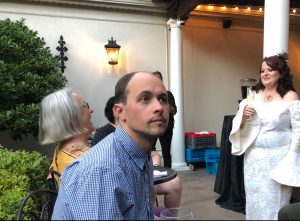
Sam hasn’t been able to go dancing–one of his favorite things–much at all for the past year and half. He joined an Eastern swing dance club several years ago, but they closed with the first covid lockdown last year and opened for a club dance only once, as far as Sam can tell, just before the surge of the delta variant put a damper on everything again. I think the only time he’s been out is when his aunties took him dancing on a mountain biking trip in June. (Remember June, when we thought we were finally free of it?)
On the way to the wedding, I told him there would be a DJ and music and a chance to dance. He said he wasn’t sure about staying at the party that long, let alone dancing. “It’s risky, Mom,” he said.
But, as you can see in the photo above, his eyes were soon on the dance floor. He waited for a bit, hoping a the DJ would spin a good swing dance number, but after a few tunes, he decided he would just make his move. He danced quite a bit, including at least one number with the bride. He’s a lucky guy that way.
